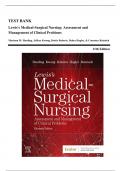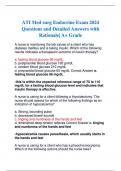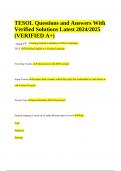TEST BANK
Lewis's Medical-Surgical Nursing: Assessment and
Management of Clinical Problems
Mariann M. Harding, Jeffrey Kwong, Dottie Roberts, Debra Hagler, & Courtney Reinisch
11th Edition
,Table of Contents
Chapter 01 Professional Nursing 1
Chapter 02 Health Equity and Culturally Competent Care 10
Chapter 03 Health History and Physical Examination 17
Chapter 04 Patient and Caregiver Teaching 23
Chapter 05 Chronic Illness and Older Adults 31
Chapter 06 Stress Management 39
Chapter 07 Sleep and Sleep Disorders 44
Chapter 08 Pain 48
Chapter 09 Palliative and End of Life Care 58
Chapter 10 Substance Use Disorders 65
Chapter 11 Inflammation and Healing 75
Chapter 12 Genetics 83
Chapter 13 Immune Responses and Transplantation 86
Chapter 14 Infection 96
Chapter 15 Cancer 106
Chapter 16 Fluid, Electrolyte, and Acid-Base Imbalances 122
Chapter 17 Preoperative Care 136
Chapter 18 Intraoperative Care 144
Chapter 19 Postoperative Care 151
Chapter 20 Assessment and Management-Visual Problems 161
Chapter 21 Assessment and Management-Auditory Problems 177
Chapter 22 Assessment-Integumentary System 186
Chapter 23 Integumentary Problems 191
Chapter 24 Burns 200
Chapter 25 Assessment-Respiratory System 212
Chapter 26 Upper Respiratory Problems 221
Chapter 27 Lower Respiratory Problems 231
Chapter 28 Obstructive Pulmonary Diseases 250
Chapter 29 Assessment-Hematologic System 266
Chapter 30 Hematologic Problems 271
Chapter 31 Assessment-Cardiovascular System 287
Chapter 32 Hypertension 296
Chapter 33 Coronary Artery Disease and Acute Coronary Syndrome 305
Chapter 34 Heart Failure 320
Chapter 35 Dysrhythmias 330
Chapter 36 Inflammatory and Structural Heart Disorders 342
Chapter 37 Vascular Disorders 354
Chapter 38 Assessment-Gastrointestinal System 366
Chapter 39 Nutritional Problems 372
Chapter 40 Obesity 381
Chapter 41 Upper Gastrointestinal Problems 388
,Chapter 42 Lower Gastrointestinal Problems 405
Chapter 43 Liver, Biliary Tract, and Pancreas Problems 424
Chapter 44 Assessment-Urinary System 440
Chapter 45 Renal and Urologic Problems 448
Chapter 46 Acute Kidney Injury and Chronic Kidney Disease 463
Chapter 47 Assessment-Endocrine System 477
Chapter 48 Diabetes Mellitus 485
Chapter 49 Endocrine Problems 503
Chapter 50 Assessment-Reproductive System 519
Chapter 51 Breast Disorders 526
Chapter 52 Sexually Transmitted Infections 536
Chapter 53 Female Reproductive Problems 544
Chapter 54 Male Reproductive Problems 562
Chapter 55 Assessment-Nervous System 574
Chapter 56 Acute Intracranial Problems 581
Chapter 57 Stroke 595
Chapter 58 Chronic Neurologic Problems 606
Chapter 59 Dementia and Delirium 619
Chapter 60 Spinal Cord and Peripheral Nerve Problems 627
Chapter 61 Assessment-Musculoskeletal System 639
Chapter 62 Musculoskeletal Trauma and Orthopedic Surgery 645
Chapter 63 Musculoskeletal Problems 661
Chapter 64 Arthritis and Connective Tissue Diseases 670
Chapter 65 Critical Care 686
Chapter 66 Shock, Sepsis, and Multiple Organ Dysfunction Syndrome 701
Chapter 67 Acute Respiratory Failure and Acute Respiratory Distress Syndrome 711
Chapter 68 Emergency and Disaster Nursing 721
,______________________________________________________________________________________________
Test Bank - Lewis's Medical Surgical Nursing, 10th Edition (Harding, 2020)
Chapter 01: Professional Nursing
Harding: Lewis’s Medical-Surgical Nursing, 11th Edition
MULTIPLE CHOICE
1. The nurse teaches a student nurse about how to apply the nursing process when providing
patient care. Which statement, if made by the student nurse, indicates that teaching was
successful?
a. The nursing process is a scientific-based method of diagnosing the patients health
care problems.
b. The nursing process is a problem-solving tool used to identify and treat patients
health care needs.
c. The nursing process is based on nursing theory that incorporates the
biopsychosocial nature of humans.
d. The nursing process is used primarily to explain nursing interventions to other
health care professionals.
ANS: B
The nursing process is a problem-solving approach to the identification and treatment of
patients problems. Diagnosis is only one phase of the nursing process. The primary use of
the nursing process is in patient care, not to establish nursing theory or explain nursing
interventions to other health care professionals.
DIF: Cognitive Level: Understand (comprehension)
TOP: Nursing Process: Implementation
WWW.TBSM.WS
MSC: NCLEX: Safe and Effective Care Environment
2. The nurse describes to a student nurse how to use evidence-based practice guidelines when
caring for patients. Which statement, if made by the nurse, would be the most accurate?
a. Inferences from clinical research studies are used as a guide.
b. Patient care is based on clinical judgment, experience, and traditions.
c. Data are evaluated to show that the patient outcomes are consistently met.
d. Recommendations are based on research, clinical expertise, and patient
preferences.
ANS: D
Evidence-based practice (EBP) is the use of the best research-based evidence combined with
clinician expertise. Clinical judgment based on the nurses clinical experience is part of EBP,
but clinical decision making should also incorporate current research and research-based
guidelines. Evaluation of patient outcomes is important, but interventions should be based
on research from randomized control studies with a large number of subjects.
DIF: Cognitive Level: Remember (knowledge)
TOP: Nursing Process: Planning
MSC: NCLEX: Safe and Effective Care Environment
3. The nurse completes an admission database and explains that the plan of care and discharge
goals will be developed with the patients input. The patient states, How is this different from
what the doctor does? Which response would be most appropriate for the nurse to make?
______________________________________________________________________________________________
1|Page
,______________________________________________________________________________________________
Test Bank - Lewis's Medical Surgical Nursing, 10th Edition (Harding, 2020)
a. The role of the nurse is to administer medications and other treatments prescribed
by your doctor.
b. The nurses job is to help the doctor by collecting information and communicating
any problems that occur.
c. Nurses perform many of the same procedures as the doctor, but nurses are with the
patients for a longer time than the doctor.
d. In addition to caring for you while you are sick, the nurses will assist you to
develop an individualized plan to maintain your health.
ANS: D
This response is consistent with the American Nurses Association (ANA) definition of
nursing, which describes the role of nurses in promoting health. The other responses
describe some of the dependent and collaborative functions of the nursing role but do not
accurately describe the nurses role in the health care system.
DIF: Cognitive Level: Understand (comprehension)
TOP: Nursing Process: Implementation
MSC: NCLEX: Safe and Effective Care Environment
4. A patient who is paralyzed on the left side of the body after a stroke develops a pressure
ulcer on the left hip. Which nursing diagnosis is most appropriate?
a. Impaired physical mobility related to left-sided paralysis
b. Risk for impaired tissue integrity related to left-sided weakness
c. Impaired skin integrity related to altered circulation and pressure
d. Ineffective tissue perfusion related to inability to move independently
ANS: C WWW.TBSM.WS
The patients major problem is the impaired skin integrity as demonstrated by the presence of
a pressure ulcer. The nurse is able to treat the cause of altered circulation and pressure by
frequently repositioning the patient. Although left-sided weakness is a problem for the
patient, the nurse cannot treat the weakness. The risk for diagnosis is not appropriate for this
patient, who already has impaired tissue integrity. The patient does have ineffective tissue
perfusion, but the impaired skin integrity diagnosis indicates more clearly what the health
problem is.
DIF: Cognitive Level: Apply (application)
TOP: Nursing Process: Diagnosis MSC: NCLEX: Physiological Integrity
5. A patient has been admitted to the hospital for surgery and tells the nurse, I do not feel
comfortable leaving my children with my parents. Which action should the nurse take next?
a. Reassure the patient that these feelings are common for parents.
b. Have the patient call the children to ensure that they are doing well.
c. Gather more data about the patients feelings about the child-care arrangements.
d. Call the patients parents to determine whether adequate child care is being
provided.
ANS: C
______________________________________________________________________________________________
2|Page
,______________________________________________________________________________________________
Test Bank - Lewis's Medical Surgical Nursing, 10th Edition (Harding, 2020)
Since a complete assessment is necessary in order to identify a problem and choose an
appropriate intervention, the nurses first action should be to obtain more information. The
other actions may be appropriate, but more assessment is needed before the best intervention
can be chosen.
DIF: Cognitive Level: Apply (application)
OBJ: Special Questions: Prioritization TOP: Nursing Process: Assessment
MSC: NCLEX: Psychosocial Integrity
6. A patient with a bacterial infection has a nursing diagnosis of deficient fluid volume related
to excessive diaphoresis. Which outcome would the nurse recognize as most appropriate for
this patient?
a. Patient has a balanced intake and output.
b. Patients bedding is changed when it becomes damp.
c. Patient understands the need for increased fluid intake.
d. Patients skin remains cool and dry throughout hospitalization.
ANS: A
This statement gives measurable data showing resolution of the problem of deficient fluid
volume that was identified in the nursing diagnosis statement. The other statements would
not indicate that the problem of deficient fluid volume was resolved.
DIF: Cognitive Level: Apply (application)
TOP: Nursing Process: Planning MSC: NCLEX: Physiological Integrity
7. A nurse asks the patient if pain was relieved after receiving medication. What is the purpose
WWW.TBSM.WS
of the evaluation phase of the nursing process?
a. To determine if interventions have been effective in meeting patient outcomes
b. To document the nursing care plan in the progress notes of the medical record
c. To decide whether the patients health problems have been completely resolved
d. To establish if the patient agrees that the nursing care provided was satisfactory
ANS: A
Evaluation consists of determining whether the desired patient outcomes have been met and
whether the nursing interventions were appropriate. The other responses do not describe the
evaluation phase.
DIF: Cognitive Level: Understand (comprehension)
TOP: Nursing Process: Evaluation
MSC: NCLEX: Safe and Effective Care Environment
8. The nurse interviews a patient while completing the health history and physical
examination. What is the purpose of the assessment phase of the nursing process?
a. To teach interventions that relieve health problems
b. To use patient data to evaluate patient care outcomes
c. To obtain data with which to diagnose patient problems
d. To help the patient identify realistic outcomes for health problems
ANS: C
______________________________________________________________________________________________
3|Page
,______________________________________________________________________________________________
Test Bank - Lewis's Medical Surgical Nursing, 10th Edition (Harding, 2020)
During the assessment phase, the nurse gathers information about the patient to diagnose
patient problems. The other responses are examples of the planning, intervention, and
evaluation phases of the nursing process.
DIF: Cognitive Level: Understand (comprehension)
TOP: Nursing Process: Assessment
MSC: NCLEX: Safe and Effective Care Environment
9. Which nursing diagnosis statement is written correctly?
a. Altered tissue perfusion related to heart failure
b. Risk for impaired tissue integrity related to sacral redness
c. Ineffective coping related to response to biopsy test results
d. Altered urinary elimination related to urinary tract infection
ANS: C
This diagnosis statement includes a NANDA nursing diagnosis and an etiology that
describes a patients response to a health problem that can be treated by nursing. The use of a
medical diagnosis as an etiology (as in the responses beginning Altered tissue perfusion and
Altered urinary elimination) is not appropriate. The response beginning Risk for impaired
tissue integrity uses the defining characteristic as the etiology.
DIF: Cognitive Level: Understand (comprehension)
TOP: Nursing Process: Diagnosis
MSC: NCLEX: Safe and Effective Care Environment
10. The nurse admits a patient to the hospital and develops a plan of care. What components
should the nurse include in the WWW.TBSM.WS
nursing diagnosis statement?
a. The problem and the suggested patient goals or outcomes
b. The problem with possible causes and the planned interventions
c. The problem, its cause, and objective data that support the problem
d. The problem with an etiology and the signs and symptoms of the problem
ANS: D
When writing nursing diagnoses, this format should be used: problem, etiology, and signs
and symptoms. The subjective, as well as objective, data should be included in the defining
characteristics. Interventions and outcomes are not included in the nursing diagnosis
statement.
DIF: Cognitive Level: Remember (knowledge)
TOP: Nursing Process: Diagnosis
MSC: NCLEX: Safe and Effective Care Environment
11. A nurse is caring for a patient with heart failure. Which task is appropriate for the nurse to
delegate to experienced unlicensed assistive personnel (UAP)?
a. Monitor for shortness of breath or fatigue after ambulation.
b. Instruct the patient about the need to alternate activity and rest.
c. Obtain the patients blood pressure and pulse rate after ambulation.
d. Determine whether the patient is ready to increase the activity level.
ANS: C
______________________________________________________________________________________________
4|Page
,______________________________________________________________________________________________
Test Bank - Lewis's Medical Surgical Nursing, 10th Edition (Harding, 2020)
UAP education includes accurate vital sign measurement. Assessment and patient teaching
require registered nurse education and scope of practice and cannot be delegated.
DIF: Cognitive Level: Apply (application)
OBJ: Special Questions: Delegation TOP: Nursing Process: Planning
MSC: NCLEX: Safe and Effective Care Environment
12. A nurse is caring for a group of patients on the medical-surgical unit with the help of one
float registered nurse (RN), one unlicensed assistive personnel (UAP), and one licensed
practical/vocational nurse (LPN/LVN). Which assignment, if delegated by the nurse, would
be inappropriate?
a. Measurement of a patients urine output by UAP
b. Administration of oral medications by LPN/LVN
c. Check for the presence of bowel sounds and flatulence by UAP
d. Care of a patient with diabetes by RN who usually works on the pediatric unit
ANS: C
Assessment requires RN education and scope of practice and cannot be delegated to an
LPN/LVN or UAP. The other assignments made by the RN are appropriate.
DIF: Cognitive Level: Apply (application)
OBJ: Special Questions: Delegation TOP: Nursing Process: Planning
MSC: NCLEX: Safe and Effective Care Environment
13. Which task is appropriate for the nurse to delegate to a licensed practical/vocational nurse
(LPN/LVN)?
WWW.TBSM.WS
a. Complete the initial admission assessment and plan of care.
b. Document teaching completed before a diagnostic procedure.
c. Instruct a patient about low-fat, reduced sodium dietary restrictions.
d. Obtain bedside blood glucose on a patient before insulin administration.
ANS: D
The education and scope of practice of the LPN/LVN include activities such as obtaining
glucose testing using a finger stick. Patient teaching and the initial assessment and
development of the plan of care are nursing actions that require registered nurse education
and scope of practice.
DIF: Cognitive Level: Apply (application)
OBJ: Special Questions: Delegation TOP: Nursing Process: Planning
MSC: NCLEX: Safe and Effective Care Environment
14. A nurse is assigned as a case manager for a hospitalized patient with a spinal cord injury.
The patient can expect the nurse functioning in this role to perform which activity?
a. Care for the patient during hospitalization for the injuries.
b. Assist the patient with home care activities during recovery.
c. Determine what medical care the patient needs for optimal rehabilitation.
d. Coordinate the services that the patient receives in the hospital and at home.
ANS: D
______________________________________________________________________________________________
5|Page
, ______________________________________________________________________________________________
Test Bank - Lewis's Medical Surgical Nursing, 10th Edition (Harding, 2020)
The role of the case manager is to coordinate the patients care through multiple settings and
levels of care to allow the maximal patient benefit at the least cost. The case manager does
not provide direct care in either the acute or home setting. The case manager coordinates
and advocates for care but does not determine what medical care is needed; that would be
completed by the health care provider or other provider.
DIF: Cognitive Level: Apply (application)
TOP: Nursing Process: Implementation
MSC: NCLEX: Safe and Effective Care Environment
15. The nurse is caring for an older adult patient who had surgery to repair a fractured hip. The
patient needs continued nursing care and physical therapy to improve mobility before
returning home. The nurse will help to arrange for transfer of this patient to which facility?
a. A skilled care facility
b. A residential care facility
c. A transitional care facility
d. An intermediate care facility
ANS: C
Transitional care settings are appropriate for patients who need continued rehabilitation
before discharge to home or to long-term care settings. The patient is no longer in need of
the more continuous assessment and care given in acute care settings. There is no indication
that the patient will need the permanent and ongoing medical and nursing services available
in intermediate or skilled care. The patient is not yet independent enough to transfer to a
residential care facility.
DIF: Cognitive Level: ApplyWWW.TBSM.WS
(application)
MSC: NCLEX: Safe and Effective Care Environment
16. A home care nurse is planning care for a patient who has just been diagnosed with type 2
diabetes mellitus. Which task is appropriate for the nurse to delegate to the home health
aide?
a. Assist the patient to choose appropriate foods.
b. Help the patient with a daily bath and oral care.
c. Check the patients feet for signs of breakdown.
d. Teach the patient how to monitor blood glucose.
ANS: B
Assisting with patient hygiene is included in home health-aide education and scope of
practice. Assessment of the patient and instructing the patient in new skills, such as diet and
blood glucose monitoring, are complex skills that are included in registered nurse education
and scope of practice.
DIF: Cognitive Level: Apply (application)
OBJ: Special Questions: Delegation TOP: Nursing Process: Implementation
MSC: NCLEX: Safe and Effective Care Environment
17. The nurse is providing education to nursing staff on quality care initiatives. Which statement
would be the most accurate description of the impact of health care financing on quality
care?
______________________________________________________________________________________________
6|Page






